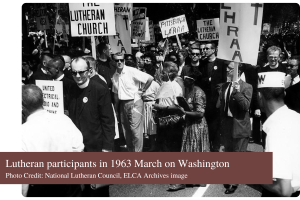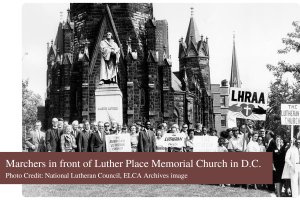 On August 28, 1963, an estimated 250,000 people gathered for the March on Washington for Jobs and Freedom, rallying to draw attention to the nation’s racial inequities and insist on change. From the steps in front of the Lincoln Memorial, several leaders moved the crowd with resonance, challenge and inspiration, including delivery of the Rev. Dr. Martin Luther King, Jr.’s iconic “I Have a Dream” speech. Just steps – literally – from the podium was Mark Raabe, long-term member of First Trinity Lutheran in Washington, D.C., who helps us all relive and reflect on that pivotal day.
On August 28, 1963, an estimated 250,000 people gathered for the March on Washington for Jobs and Freedom, rallying to draw attention to the nation’s racial inequities and insist on change. From the steps in front of the Lincoln Memorial, several leaders moved the crowd with resonance, challenge and inspiration, including delivery of the Rev. Dr. Martin Luther King, Jr.’s iconic “I Have a Dream” speech. Just steps – literally – from the podium was Mark Raabe, long-term member of First Trinity Lutheran in Washington, D.C., who helps us all relive and reflect on that pivotal day.
SIGHTS AND SOUNDS
“From the pond to the Capitol, it was a sea of people,” said Raabe. “It was a different time. People were dressed up. There weren’t any white rabble rousers – they just weren’t there. The day was peaceful and passionate.”
“The whole thing started early in the day, on a big platform on the corner of Constitution and 15th – kind of across the street from where the National Museum of African American History and Culture is now – with entertainment and speakers.” The groundswell that brought people together seemed to fuse the individuals into one. “The same crowds that arrived early just peacefully moved to the Lincoln Memorial and lined the Reflecting Pool.”
 Raabe brought his camera and has personally-photographed recollections of the profound day. Who was he most excited to see? “Lena Horne. I was secretly in love with her since I was a young high school kid,” he chuckled. Other attention-grabbing movie stars included Harry Belafonte, Burt Lancaster, Charlton Heston and others. Artists including Odetta; Peter, Paul & Mary; and Joan Baez entertained with aimed songs.
Raabe brought his camera and has personally-photographed recollections of the profound day. Who was he most excited to see? “Lena Horne. I was secretly in love with her since I was a young high school kid,” he chuckled. Other attention-grabbing movie stars included Harry Belafonte, Burt Lancaster, Charlton Heston and others. Artists including Odetta; Peter, Paul & Mary; and Joan Baez entertained with aimed songs.
The core from center stage was speeches from active civil rights movement leaders. “Of course, there was Dr. King, Ralph Abernathy, Whitney Young from the National Urban League, James Farmer, John Lewis and [A.] Philip Randolph, head of the Brotherhood of Sleeping Car Porters union, which was a very strong position.” Also standing out for Raabe were Black and white “clergymen very active in the civil rights movement.”
“In 1963 there wasn’t any cable, and I’m not sure if the news on TV carried the speeches live or not, but news reel cameras have shown them many times since. No kidding at all – I knew this was a great moment and that the country would never be the same.”
PERSONAL PRESENCE
 After a long career as counsel to a committee of Congress, Raabe can look back at his presence at the March in a professional capacity as a personal experience as well. “I didn’t have a lot of [varied racial] experience as a [white] kid growing up in Minnesota, not even in my law school class,” he recalled. But life experiences brought him greater exposure. “Only six years earlier [than the March] I was a newly married Navy guy, and we attended a Black Lutheran church in San Diego.” After visiting several churches at that time, the young couple was drawn to the vitality of the congregation they became part of. “We were absolutely received there,” he said.
After a long career as counsel to a committee of Congress, Raabe can look back at his presence at the March in a professional capacity as a personal experience as well. “I didn’t have a lot of [varied racial] experience as a [white] kid growing up in Minnesota, not even in my law school class,” he recalled. But life experiences brought him greater exposure. “Only six years earlier [than the March] I was a newly married Navy guy, and we attended a Black Lutheran church in San Diego.” After visiting several churches at that time, the young couple was drawn to the vitality of the congregation they became part of. “We were absolutely received there,” he said.
“The March was more like a confirmation of some feelings I had about the Black movement before this,” and the exposure continued to impact his personal and professional choices going forward.
POWERFULLY PEACEFUL
“I went home that day and told my wife I had witnessed history,” Raabe marked. “There have been many watershed moments in civil rights, and this may have been the greatest watershed of all.”
There was “big discussion” before the March of possible erupting tensions. Would the March be peaceful? “The day was unbelievably calm – not on edge at all.” Even with such weighty matters before the nation, Raabe experienced the day as enjoyable. “It was a magnificent experience to be there and to hear the speeches and to be able to take it in at the moment.”
 “I knew when Dr. King gave that speech that this was a speech for the ages. It absolutely was a stunning and emotional, real emotional, moment for me and the crowd.”
“I knew when Dr. King gave that speech that this was a speech for the ages. It absolutely was a stunning and emotional, real emotional, moment for me and the crowd.”
“As great as that day was, it showed the power of peaceful protest. When you have that kind of positive power in one direction for good,” there will be powerful impact, Raabe said. “You’re always going to have sinister forces of evil who don’t agree, or who respond by attacking verbally or even physically. Dr. King went to jail in response to what he was doing. Ultimately he paid with his life. But he accomplished incredible things in a peaceful way.”
“That’s kind of my approach to life. Do things by pointing out the morality or immorality of something and preaching that message rather than violence or destruction – George Floyd or any injustices we face. Violence only breeds more hostility and slows progress,” Raabe continued.
“My personal feeling is Dr. King showed by example what we could do by persistent, peaceful protest on strong moral grounds.”
Raabe was able to marvel at the crowd of 250,000 on August 28, 1963. In his mind’s eye, “It might have been even bigger.” The impact of that March on Washington certainly was.
